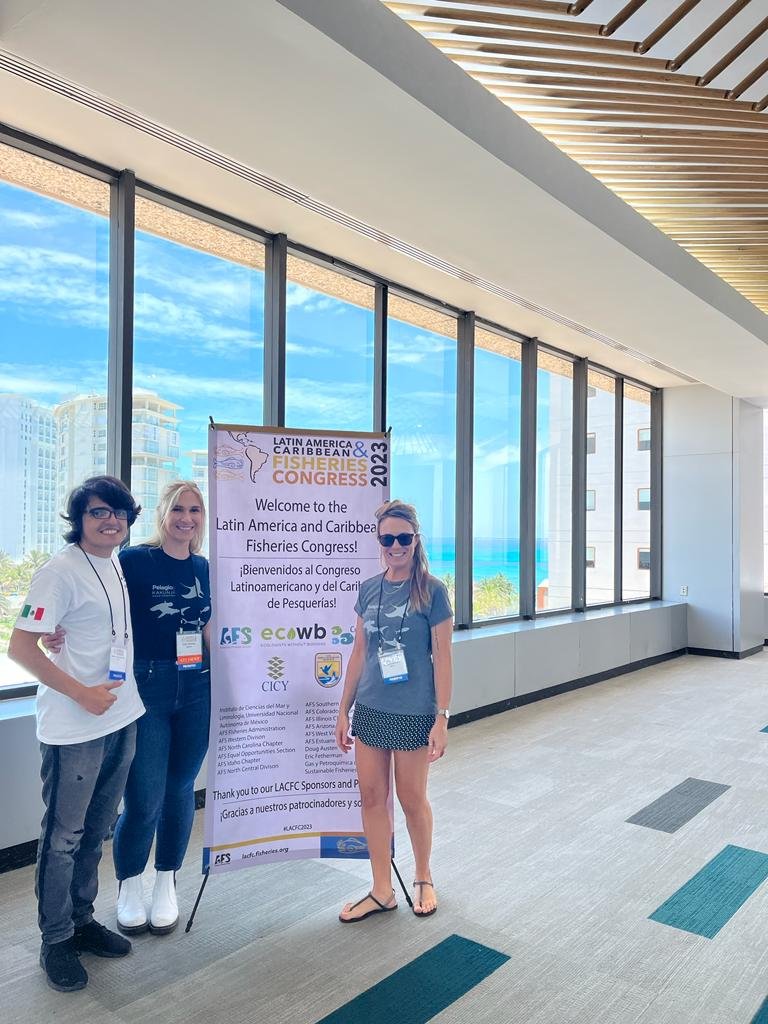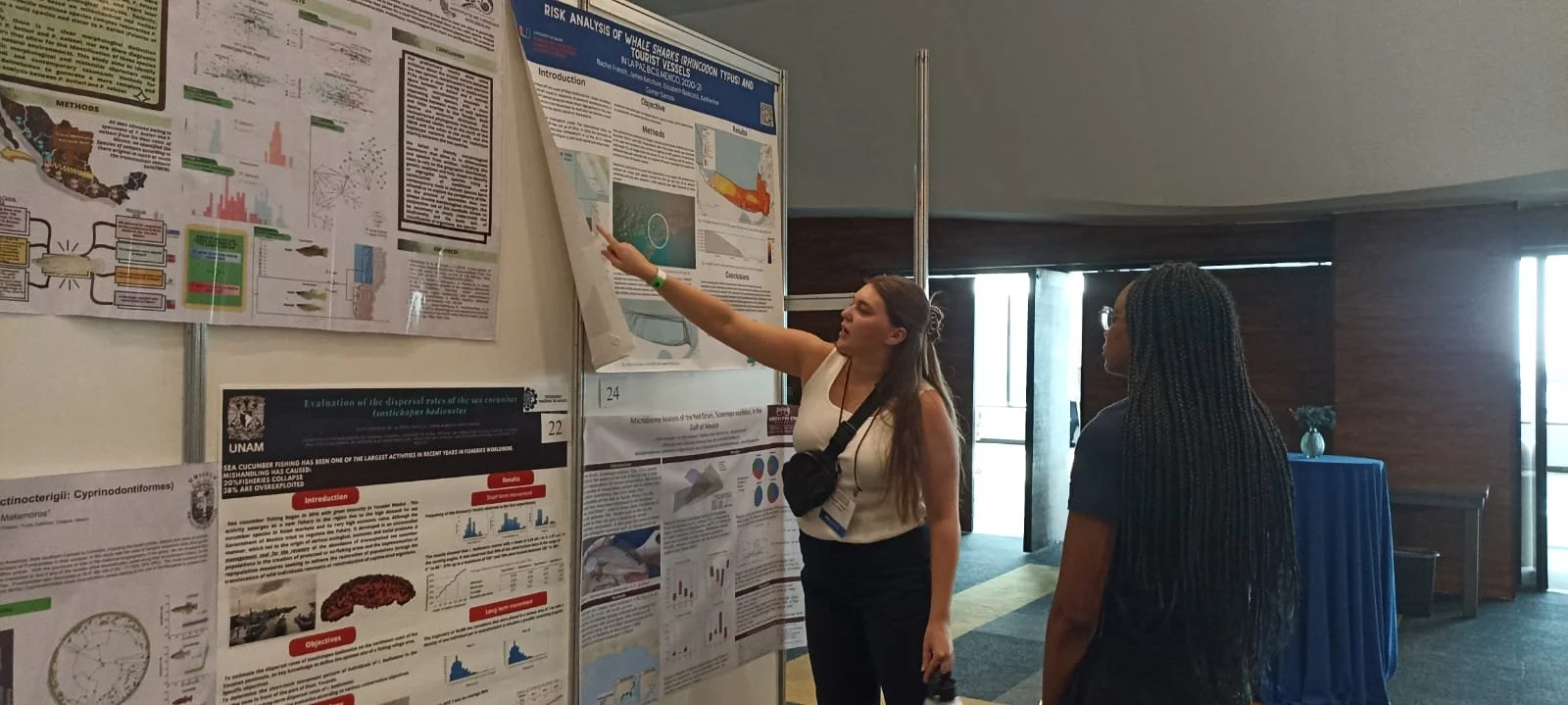The Pelagios team participates in the Latin America and Caribbean Fisheries Congress (LACFC)
By Pelagios Kakunjá
This week the Pelagios Team -students and staff- will be participating in the Latin America and Caribbean Fisheries Congress (LACFC). This event will take place at the Cancun Convention Center from May 15-18. Check out the schedule of our team’s presentations about their research on mantas and sharks in Mexico!
POSTERS
Tuesday, May 16
📍Gran Cancun G, Cancun Convention Center
Evaluation of the reproductive condition of Carcharhinid sharks in the Revillagigedo Archipelago
Irene Casanova
Abstract:
Sharks of the genus Carcharhinidae; Carcharhinus albimarginatus, Carcharhinus falciformis and Carcharhinus galapagensis, are distributed in the Revillagigedo Archipelago (RA), the largest Marine Protected Area (MPA) in North America. Some of these sharks are known to migrate between several oceanic islands in the Eastern Tropical Pacific, which makes them vulnerable to national and multinational high seas fisheries. A conservation priority for sharks is to determine the reproductive cycles and areas associated with their reproduction. In addition, when dealing with pregnant females that spend a large part of their lives within an MPA, it is essential to use methodologies that ensure the survival of the animal. The objective of this study is to know the reproductive status of C. albimarginatus, C. falciformis and C. galapagensis females in the RA through non-lethal methodologies. For this purpose, several mature and potentially pregnant females were analyzed from January to April in the years 2022 and 2023. Physical parameters such as total length and distended or non-distended belly were taken. An Ibex-Pro ultrasound scanner was used in order to observe images of each female's uterus and assess pregnancy status. Currently, one pregnant female of C. albimarginatus, three of C. falciformis and two of C. galapagensis were found, the analysis of the ultrasound images is still in progress.
Keywords::
Fish Reproduction/Development,Marine,Survey Methods
Risk Analysis of Whale Sharks (Rhincodon typus) and Tourist Vessels in Bahía de la Paz, Mexico
Rachel French
Abstract:
The Bay of La Paz (BLP) is in Baja California Sur, just North of the city of La Paz, Mexico. This region is known for the seasonal aggregations of whale sharks (Rhincodon typus), primarily juvenile males, during the months of October to March. The seasonal aggregation is due to an increase in planktonic organisms, determined by shifts in the cyclonic eddy system of the closed bay. Seasonal shifts in this circulation system influence nutrient richness and therefore whale shark abundance and distribution. In recent years, the whale shark aggregations have shifted from the eastern part of the bay to El Mogote, or the sandbar. This research aims to investigate and analyze the relationship between these aggregations and tourist vessel infractions. Data collected from the 2020-2021 season from Pelagios Kakunja and a WWF report was used in this project. Ecotourism is a major contributor to the local economy in La Paz, especially whale shark tours which often include the ability to swim with the animal. Depth profiles and Getis-Ord Gi* Hotspot Analysis allowed for identification of highest and lowest risk areas for whale sharks determined by vessel speed infractions and current shark distribution patterns. This study will allow for a better understanding of R. typus spatial distribution and migrations in BLP and provide useful data for tourist and conservation agencies.
Keywords::
Ecology, Human Dimensions, Threatened and Endangered Species
TALKS
Batoids of Latin America and the Caribbean Day 2 (Symposium)
Wednesday, May 17
📍Costa Maya 4, Cancun Convention Center
2:10 PM-2:30 PM
Population dynamics of oceanic manta rays in the Mexican Pacific
Madalena Pereira Cabral, PhD(c) , UABCS; Hector Reyes Bonilla, Dr., Professor-researcher, Universidad Autonoma de Baja California Sur; James Ketchum, Pelagios Kakunjá.
Abstract:
Oceanic manta rays Mobula birostris are declining globally due to fisheries. Past work has shown that movements and distributions of oceanic manta ray populations are sensitive to climatic fluctuations such as the El Niño Southern Oscillation. The Revillagigedo National Park (RNP) in Mexico is the largest Marine Protected Area in North America and is a well-known aggregation site for oceanic manta rays. However, published baseline data on population structure and dynamics, and the influence of oceanographic variables on the abundance of oceanic manta rays in the region are lacking. We used 2015–2019 photo-identification data to describe baseline demographic characteristics of this population and to evaluate the infuence of environmental factors on population dynamics. A signifcant sex bias was found with a female:male ratio of 1.4:1. Mark-recapture (MR) was used to estimate monthly abundance and provided the first superpopulation size estimate of 1172 (±90), representing all individuals using the RNP during the survey period. High survival rates suggest long-term fidelity to the archipelago and the RNP is considered a refuge due to oceanographic conditions that counterbalance the negative effects of extreme El Niño. These findings provide a baseline to support efective conservation and management plans for this endangered species in the Mexican Pacific. In addition, other approaches such as satellite telemetry are being used to understand the full distribution range of this population, their movement patterns out of the marine protected area, as oceanic manta ray populations are vulnerable to fisheries pressure (bycatch) in this region, as well as the environmental variables that drive them.
Keywords::
Ecology, Marine, Population Dynamics, Tags and Tagging, Threatened and Endangered Species
2:30 PM-2:50 PM
A Picture’s Worth: Using Photo-ID to Describe the Population Structure of Caribbean Mantas
Jane Vinesky, Centro Interdisciplinario de Ciencias Marinas del Instituto Politécnico Nacional, Pelagios Kakunjá; Silvia Alejandra Hinojosa Alvarez, Dra., Instituto Tecnologico y de Estudios Superiores de Monterrey; Maurico Hoyos-Padilla, PhD, Pelagios Kakunjá; Felipe Galvan Magaña, PhD, Centro Interdisciplinario de Ciencias Marinas del Instituto Politécnico Nacional; Rodrigo Friscione, Pelagic Life.
Abstract:
Although mantas are among the most charismatic extant fishes, many questions remain about their spatial and temporal distribution. Oceanic mantas (Mobula birostris) and Reef mantas (Mobula alfredi) are thought to share global distribution throughout tropical, subtropical, and temperature waters. Caribbean mantas (Mobula c.f. birostris), a possible third species, are native to the Mexican Yucatán Peninsula and are hypothesized to be resident. Understanding of Caribbean mantas is limited. Studies focused on distribution, population structure, and population size baselines are lacking. To contribute to these baselines, we utilized photographic identification (photo-id) based mark-recapture on a dataset ranging from August 2010 to September 2022. Photo-id of Caribbean mantas was collected during ‘manta season’, which ranges from April to September. Sightings were collected from Isla Holbox, Isla Contoy, and a dive site colloquially called ‘Manta Valley’ which is found within the Cabo Catoche continental shelf. Sightings include demographic data like color morph, sex, and life stage when possible. Analysis of results is ongoing, but given the global decline in mantas, obtaining baseline data is crucial to monitoring population status and conservation efforts going forward.
Keywords::
Ecology, Marine, Threatened and Endangered Species
2:50 PM-3:10 PM
Quantifying Manta-tourism interactions in Mexico's manta aggregation sites.
Miguel de Jesus Gomez Garcia, Pelagios Kakunja AC; María del Carmen Blázquez-Moreno, PhD, CIBNOR; Joshua Stewart, PhD, Oregon State University; Vianey Leos Barajas, PhD, University of Toronto; Iliana Fonseca Ponce, M.Sc, Manta Trust; Aldo Zavala Jimenez, PhD, Manta Trust; Fuentes Karen, Manta Caribbean Project; James Ketchum, Pelagios Kakunjá.
Abstract:
Manta rays, the largest mobulid rays, are subjected to exploitation and overfishing in certain parts of the world. Tourism has been supported as a sustainable alternative for the conservation of the species, and a potential source of economic spillover to local populations. Nevertheless, the effects of tourism over these highly social animals remains unknown. Manta rays aggregate at three sites in Mexico: The Revillagigedo Archipelago and Banderas Bay in the Pacific, and the area around Isla Contoy National Park in the Caribbean. We analyzed the behavior of manta rays using video data collected by local researchers and tourism operators to determine how diver behaviors and techniques affected them. Diver activities were grouped into passive and active categories. We described 16 behaviors and grouped them into four behavioral states: Directional, erratic, attraction and evasion to divers. Manta rays in Banderas Bay and Revillagigedo displayed a higher frequency of erratic behaviors than at Isla Contoy, while Banderas Bay manta rays transitioned to evasion behaviors more often. Manta rays responded similarly in both sites to active divers. At freediving sites, manta rays from Isla Contoy displayed evasion less frequently than at Banderas Bay. Changes in manta ray behavior were similar for both sites, but mantas in Banderas Bay transitioned to evasion more with active divers. The increased food availability for Isla Contoy manta rays could be the reason for the reduced response toward divers in this site. The existence of additional stressors such as both traffic in Banderas Bay could be causing the mantas in this site to respond more frequently to active divers. This study, the first of its kind in oceanic and Caribbean manta rays, highlights that regulations and the use of best practices are vital for achieving longer and less disturbing encounters for both manta rays and divers.
Keywords::
Behavior, Human Dimensions, Marine, Threatened and Endangered Species
Blog publication date: May 15, 2023




